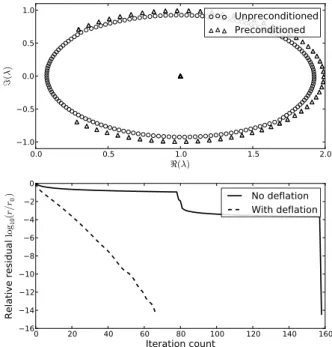Acceleration of the convergence of a non-overlapping domain decomposition method
by an approximate deflation technique for high-frequency wave propagation
A. Vion
1, B. Thierry
1and C. Geuzaine
11
University of Li`ege, Dept. of Electrical Engineering and Computer Science, B-4000 Li`ege, Belgium
Abstract— The analysis of a non-overlapping domain decom-position method with optimized transmission conditions, applied to a simplified 1-D problem discretized by finite elements, is performed to better understand the spectral properties of the method. An approximate deflation preconditioner is then introduced to modify the spectrum of the iteration operator, and speed up the convergence of the GMRES algorithm used to solve the substructured problem.
I. INTRODUCTION
Domain Decomposition Methods (DDM), combined to clas-sical discretization methods and Krylov solvers, are very pow-erful for numerically solving PDEs. Though many variations of these methods have been described in the literature, few of them have proved to be effective in dealing with wave propagation, especially at high frequencies [1]. The main reason for the poor convergence of the solvers is to be found in the spectral properties of the associated iteration operator. It is therefore natural to try and get more insights on the spectrum of the operator, improve its spectral properties and speed up convergence.
II. PROBLEM SETTING ANDDDMALGORITHM
As a simplified test problem, we solve the 1-D Helmholtz
equation with wavenumber k in an interval ¯Ω = [0, 1],
with Dirichlet boundary conditions on one side and Som-merfeld radiation condition to truncate the domain on the other side. The domain is decomposed into N equal-size,
non-overlapping subdomains Ωi,1≤i≤N, with artificial boundaries
Σij= Σjibetween Ωiand Ωj. The iterative scheme, detailed
in [2], uses impedance-type boundary conditions on Σij and
recasts the problem in terms of the set of interface data g = {gij, 1 ≤ i 6= j ≤ N, |i − j| = 1}: ∂nu (m+1) i + Su (m+1) i = −∂nu (m) j + Su (m) j on Σij = g(m)ij , with the update:
g(m+1)ij = −∂nu (m+1) j + Su (m+1) j on Σij = −gji(m)+ 2Su(m+1)j .
We choose the operator S = −ik, i.e. the DtN map for the problem, for optimizing the convergence [3]. This procedure can be rewritten as a fixed point iteration on the unknowns g:
F g = b, with F = I − A, (1)
where applying the operator A amounts to solving the sub-problems and updating g. The solution of problem (1) can be accelerated using a Krylov subspace method, e.g. GMRES. We are therefore interested in the spectrum of operator F , that strongly influences the convergence of the solver.
0.0 0.5 1.0 1.5 2.0 <(λ) 1.0 0.5 0.0 0.5 1.0 = (λ ) Unpreconditioned Preconditioned 0 20 40 60 80 100 120 140 160 Iteration count 16 14 12 10 8 6 4 2 0 Re lat ive re sid ua l lo g10 (r /r0 ) No deflation With deflation
Fig. 1. (a) Eigenvalues distribution and (b) convergence of the GMRES algorithm used to solve the unpreconditioned and deflated systems. A combination of 42 backward and forward plane waves with wavenumbers k0±p = ±(k + 5p)−10≤p≤10was used as deflation basis. N = 80
subdo-mains ; k = 188.5.
III. SPECTRAL ANALYSIS AND APPROXIMATE DEFLATION
For the purpose of this analysis, the eigenvalues and eigen-vectors of operator F are computed and the eigenvalues are plotted on Fig. 1(a). They are distributed along a circle centered at (1, 0), with some of them approaching (0, 0). These small eigenvalues cause the GMRES algorithm to fail in building a small dimension subspace containing a good approximation of the solution g. Using a (right) preconditioner
QH inspired by eigenvalues deflation techniques [4], [5] to
relocate the smallest eigenvalues at (1, 0), but using plane
waves with different wavenumbers k0p as deflation vectors,
produces a modification of the spectrum such that the
eigen-values of F QH are arranged on a slightly larger circle,
without the smallest ones in magnitude. The convergence of the preconditioned system is smoother and faster, as shown on Fig. 1(b). Further results will be included in the full paper.
REFERENCES
[1] O. Ernst and M. Gander, “Why it is difficult to solve Helmholtz prob-lems with classical iterative methods,” Numerical Analysis of Multiscale Problems, 2011.
[2] Y. Boubendir, X. Antoine, and C. Geuzaine, “A quasi-optimal non-overlapping domain decomposition algorithm for the Helmholtz equa-tion,” Journal of Computational Physics, vol. 231, no. 2, 2012. [3] F. Nataf, “Interface connections in domain decomposition methods,”
NATO Science Series II, vol. 75, 2001.
[4] J. Erhel, K. Burrage, and B. Pohl, “Restarted gmres preconditioned by deflation,” Journal of Computation and Applied Math., vol. 69, 1996. [5] Y. A. Erlangga and R. Nabben, “Multilevel projection-based nested krylov
iteration for boundary value problems,” SIAM J. Scientific Computing, vol. 30, no. 4, 2008.
